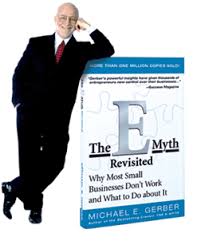The E-Myth Revisited:
Why Most Small Businesses Fail & What to Do About It
Michael E. Gerber, Publisher: HarperBusiness
Michael E. Gerber is founder and CEO of E-Myth Worldwide, based in Santa Rosa, California. He is the bestselling author of The E-Myth Contractor, The Power Point, The E-Myth, The E-Myth Revisited, and The E-Myth Manager. He is also a successful speaker and small business expert.
These days so m any things begin with “E” (email, eZine, eCommerce, eMarketing) that the title of this book probably has something to do with the internet or some other form of electronic communication. Right? Wrong!
any things begin with “E” (email, eZine, eCommerce, eMarketing) that the title of this book probably has something to do with the internet or some other form of electronic communication. Right? Wrong!
Back in 1986 Gerber wrote about what he called the “E-Myth”, the mistaken belief that entrepreneurs have that they will succeed because of the technical knowledge they possess. So “E” means “entrepreneur” and that’s what his famous series of books are all about.
The “Revisited” edition uses a case-study approach that ensures the message will be easily understood. This book focuses on developing a good business strategy and on the leadership skills required to grow a business and achieve objectives. It provides a step-by-step approach to implementing these ideas in the real world.
Even if 40 percent of small businesses fail within their first year, Gerber says there are ways to be successful. In this revision of his original work he explains the “E-Myth,” then outlines a precise business methodology that produces consistent and positive results; entrepreneurial businesses can thrive if they harness the power of innovation.
Gerber has developed a thoroughly-organized regimen that takes care of the daily details of running a business. Follow these steps meticulously to handle the day-to-day stuff and thereby free the entrepreneur’s mind to build the success of the enterprise. Anything in the book that ventures into the theoretical is well-explained in language most business owners can easily understand.
Michael Gerber cuts through many of the myths about starting your own business and shows how believing in these myths can inhibit success. He describes the steps in the life of a business – entrepreneurial infancy, adolescent growing pains, then the mature entrepreneurial perspective — and how the lessons learned along the way can be recreated for those just starting out.
He plays heavily on the difference in outcomes between those who work on their business and those who work in their business.
This is also an excellent book for technicians and managers as well as the entrepreneur. It says that employers today want more from employees than just technical proficiency. They want people who can analyze their business and provide viable technical solutions that contribute to a good work environment as well as to bottom line success. The entrepreneurial spirit in employees can be tapped and will increase the organization’s chances for success.
The book is also a practical guide to business problem solving. It can be used to design management information systems and implement effective training in any type of size of business.
In simplest terms, this book should be required reading for anyone that owns or is thinking about starting a business.
This book review was originally published in the February 2004 edition of ONEderings ezine.
Copyright 2005, RAN ONE Inc. All rights reserved. Reprinted with permission from www.ranone.com.

 Chris’ combination of academic credentials, career experience and temperament ideally suit his calling as a business development advisor. Clients say he has a mind for business and a heart for service.
Chris’ combination of academic credentials, career experience and temperament ideally suit his calling as a business development advisor. Clients say he has a mind for business and a heart for service.